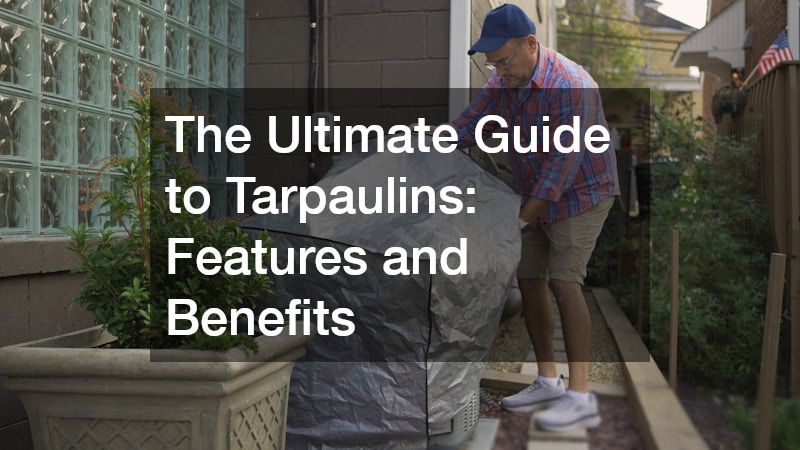Tarpaulins have become an essential part of both domestic and commercial applications in Australia. From protecting valuable assets from the elements to providing temporary shelter in emergencies, tarpaulins offer a practical and versatile solution.
Their durability and flexibility make them ideal for a wide range of tasks across various industries, including construction, agriculture, transport and camping. This ultimate guide explores the key features and benefits of tarpaulins to help you understand why they are so widely used and how to choose the right one for your needs.
Understanding the Material & Design
Tarpaulins are typically made from a range of materials including polyethylene, canvas, PVC and mesh. Each of these options comes with its own advantages depending on the intended application. Polyethylene tarps are lightweight, waterproof and UV resistant, making them highly suitable for general outdoor use. PVC tarps, on the other hand, offer superior strength and are often used in heavy-duty or industrial environments due to their robustness and ability to withstand extreme conditions.
Canvas tarps, traditionally made from cotton, are breathable yet water-resistant and ideal for covering items that need ventilation to prevent condensation. Mesh tarps provide shade and airflow while protecting against debris and wind, often utilised in horticulture or sports venues. Whichever material you choose, the construction quality plays a critical role. Features like reinforced edges, rust-resistant eyelets and heat-sealed seams add to a tarp’s reliability and longevity, ensuring it stands up to repeated use.
Weather Resistance & Durability
One of the most valuable features of tarpaulins is their ability to resist harsh weather conditions. Whether it’s shielding equipment from heavy rain or providing UV protection in the scorching Australian sun, tarps serve as a frontline defence against environmental elements. Most tarpaulins are treated with UV stabilisers to prevent material degradation over time, a crucial consideration when exposed to prolonged sunlight.
High-quality tarps are also resistant to mildew and rot, which is essential in humid or wet environments. Some varieties are flame retardant, making them suitable for use near open flames or in fire-prone areas. For users requiring long-term reliability, it’s advisable to invest in tarps with a higher GSM (grams per square metre) rating. A heavier GSM often indicates greater strength, tear resistance and overall durability, which are especially important in industrial or construction settings where wear and tear are commonplace.
Versatility Across Applications
The versatility of tarpaulins is one of their most compelling advantages. In the building industry, tarps are commonly used to cover scaffolding, protect construction materials or create temporary roofs. For farmers and those in rural areas, tarps are ideal for covering hay, feed and machinery. Transport operators regularly use heavy-duty tarps to secure loads on trucks and trailers, ensuring cargo remains protected throughout its journey.
In domestic settings, tarpaulins serve a variety of functions such as covering outdoor furniture, firewood or vehicles. Campers and outdoor enthusiasts also rely on them for ground cover, makeshift shelters or as a windbreak. Their portability and ease of setup make them especially useful in emergency scenarios where rapid deployment is required, such as during natural disasters or temporary relocations.
Cost Efficiency & Reusability
When it comes to cost-effectiveness, tarpaulins offer significant value for money. Their long lifespan, particularly when cared for correctly, means they can be reused multiple times without losing their effectiveness. Even with regular exposure to the elements, quality tarps can endure years of use, reducing the need for frequent replacements. This not only saves money in the long run but also supports sustainable practices by minimising waste.
Easy maintenance also contributes to their cost efficiency. Most tarps can be cleaned with a hose or mild detergent and storing them in a dry, shaded area helps extend their life. The initial investment in a good tarp often pays for itself many times over through repeated use and minimal upkeep, especially when compared to makeshift or single-use alternatives.
Choosing the Right Tarpaulin
Selecting the right tarpaulin requires consideration of several factors, including size, weight, material and intended use. It’s important to measure the area you need to cover and select a tarp that provides adequate overlap to ensure full protection. Weight and thickness are equally vital; while a lightweight tarp may be easier to handle, a heavier-duty tarp will offer enhanced durability and weather resistance.
Material choice should align with your specific needs. For temporary outdoor protection, polyethylene or mesh may be sufficient. For long-term or industrial use, investing in PVC or canvas may be a better choice. Eyelet spacing, rope reinforcement and UV protection are additional features that enhance functionality and should not be overlooked when making your selection.
Final Thoughts on Tarpaulin Benefits
Tarpaulins remain one of the most adaptable, affordable and durable protective solutions on the market. Their ability to withstand harsh weather, shield assets and serve a multitude of purposes makes them indispensable for both individuals and industries. By understanding the different materials, key features and proper maintenance practices, you can ensure you’re getting the best performance and value out of your tarps.
Whether you’re a homeowner looking to protect your garden gear or a business operator managing site logistics, tarpaulins provide the peace of mind that comes with reliable, all-weather coverage. Choosing the right tarp for your needs isn’t just a practical decision—it’s an investment in protection, efficiency and resilience.




